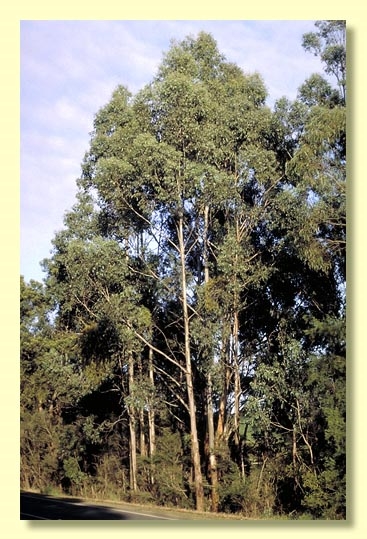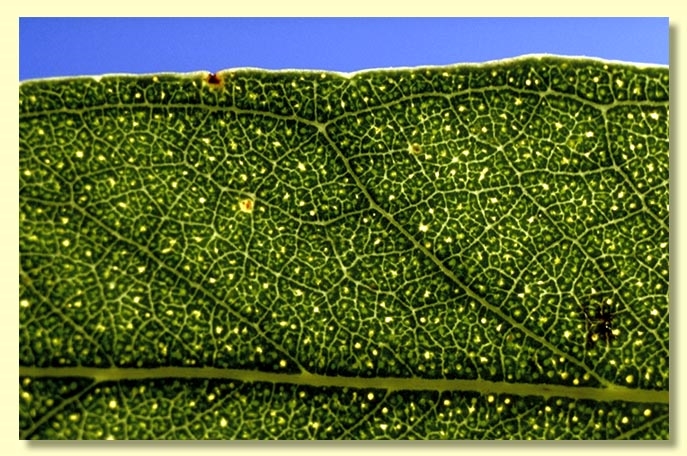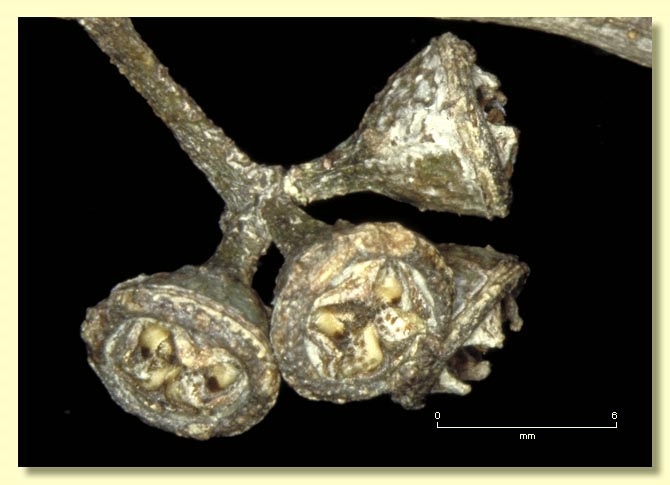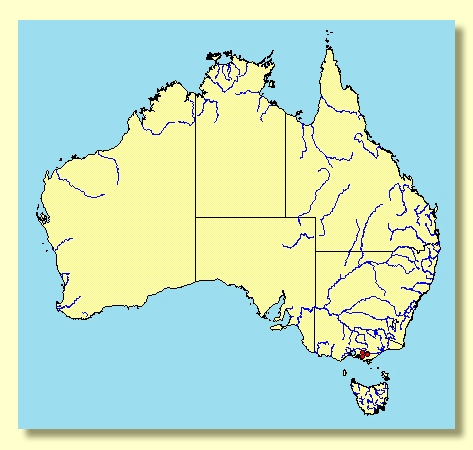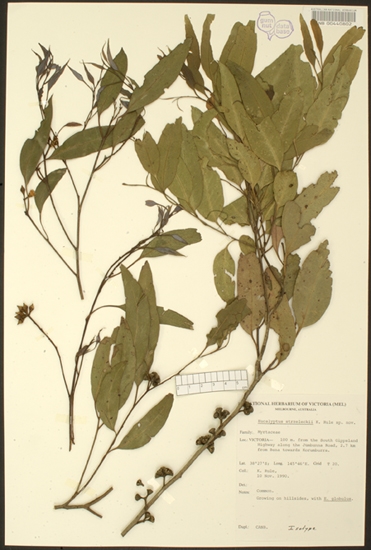Euclid - Online edition
Eucalyptus strzeleckii
Classification
Eucalyptus | Symphyomyrtus | Maidenaria | Triangulares | Foveolatae
Nomenclature
Eucalyptus strzeleckii Rule, Muelleria 7: 497 (1992).
T: 100 m from the South Gippsland Hwy along the Jumbunna Road, 2.7 km from Bena towards Korumburra, 3827S, 14546E, 10 Nov. 1990, K.Rule s.n.; holo: MEL 1598217; iso: CANB.
T: 100 m from the South Gippsland Hwy along the Jumbunna Road, 2.7 km from Bena towards Korumburra, 3827S, 14546E, 10 Nov. 1990, K.Rule s.n.; holo: MEL 1598217; iso: CANB.
Description
Tree to 30 m tall. Forming a lignotuber.
Bark smooth throughout or with some slabs of fibrous grey to brown bark persistent at base of trunk; smooth bark mottled cream, yellow, pale brown, pinkish and green, often with ribbons of decorticated bark in the upper branches, branchlets non-glaucous.
Juvenile growth (coppice or field seedlings to 50 cm): stem square or rounded in cross-section, not glaucous, warty; juvenile leaves always petiolate, opposite for few nodes then alternate, ovate, 4–8 cm long, 1.5–4.7 cm wide, margin entire or crenulate, green; new growth tips glaucous.
Adult leaves alternate, petiole 1.2–3.1 cm long; blade lanceolate to ovate or falcate, 7.5–21.5 cm long, 1.4–3.3 cm wide, conspicuously undulate, base tapering to petiole, concolorous, glossy, dark green, side-veins greater than 45° to midrib, moderately to densely reticulate, intramarginal vein parallel to and well removed from margin, oil glands island and intersectional; new growth tips in mature crown strikingly glaucous.
Inflorescence axillary unbranched, peduncles 0.5–1.4 cm long, buds 7, pedicellate, pedicels 0.3–0.5 cm long. Mature buds ovoid to diamond-shaped (0.5–0.7 cm long, 0.3–0.4 cm wide), green to yellow, scar present, operculum beaked (0.3–0.4 cm long), stamens inflexed or irregularly flexed, anthers cuboid or cuneate, versatile, dorsifixed, dehiscing by longitudinal slits (non-confluent), style long, stigma blunt, locules 3 or 4, the placentae each with 4 vertical ovule rows. Flowers white.
Fruit pedicellate, pedicels 0.2–0.5 cm long, obconical, 0.3–0.5 cm long, 0.5–0.7 cm wide, disc raised-annular to convex, or level, valves 3 or 4, near rim level to slightly enclosed.
Seeds black or brown, 1–2.5 mm long, ovoid or flattened-ovoid, often pointed at one end, slightly lacunose, dorsal surface slightly pitted or smooth, hilum ventral.
Cultivated seedlings (measured at ca node 10): cotyledons bilobed; stems usually square in cross-section, slightly warty; leaves always petiolate, opposite for 5 to 8 nodes then alternate, ovate-elliptic, 4–5 cm long, 2–3 cm wide, base rounded to truncate, margin entire or subcrenulate, apex pointed or rounded, only slightly discolorous, mid-green above, paler below.
Bark smooth throughout or with some slabs of fibrous grey to brown bark persistent at base of trunk; smooth bark mottled cream, yellow, pale brown, pinkish and green, often with ribbons of decorticated bark in the upper branches, branchlets non-glaucous.
Juvenile growth (coppice or field seedlings to 50 cm): stem square or rounded in cross-section, not glaucous, warty; juvenile leaves always petiolate, opposite for few nodes then alternate, ovate, 4–8 cm long, 1.5–4.7 cm wide, margin entire or crenulate, green; new growth tips glaucous.
Adult leaves alternate, petiole 1.2–3.1 cm long; blade lanceolate to ovate or falcate, 7.5–21.5 cm long, 1.4–3.3 cm wide, conspicuously undulate, base tapering to petiole, concolorous, glossy, dark green, side-veins greater than 45° to midrib, moderately to densely reticulate, intramarginal vein parallel to and well removed from margin, oil glands island and intersectional; new growth tips in mature crown strikingly glaucous.
Inflorescence axillary unbranched, peduncles 0.5–1.4 cm long, buds 7, pedicellate, pedicels 0.3–0.5 cm long. Mature buds ovoid to diamond-shaped (0.5–0.7 cm long, 0.3–0.4 cm wide), green to yellow, scar present, operculum beaked (0.3–0.4 cm long), stamens inflexed or irregularly flexed, anthers cuboid or cuneate, versatile, dorsifixed, dehiscing by longitudinal slits (non-confluent), style long, stigma blunt, locules 3 or 4, the placentae each with 4 vertical ovule rows. Flowers white.
Fruit pedicellate, pedicels 0.2–0.5 cm long, obconical, 0.3–0.5 cm long, 0.5–0.7 cm wide, disc raised-annular to convex, or level, valves 3 or 4, near rim level to slightly enclosed.
Seeds black or brown, 1–2.5 mm long, ovoid or flattened-ovoid, often pointed at one end, slightly lacunose, dorsal surface slightly pitted or smooth, hilum ventral.
Cultivated seedlings (measured at ca node 10): cotyledons bilobed; stems usually square in cross-section, slightly warty; leaves always petiolate, opposite for 5 to 8 nodes then alternate, ovate-elliptic, 4–5 cm long, 2–3 cm wide, base rounded to truncate, margin entire or subcrenulate, apex pointed or rounded, only slightly discolorous, mid-green above, paler below.
Flowering Time
Flowering has been recorded in October.
Notes
Eucalyptus strzeleckii is a small to medium-sized woodland or forest tree of restricted distribution east of Westernport Bay south-east of Melbourne, extending across the western section of the Strzelecki Range, from Foster north to Neerim South and east to just north of Moe. Plants collected in 2011 west of Geelong in the Forrest–Birregurra area on the northern side of the Otway Ranges are also this species.
Whilst belonging to the swamp gum group, E. strzeleckii occurs more on ridges and slopes than in wet situations. It is distinguished from other tree species in the area by the glaucous new leaf growth on the outside of the crown, small ovoid to diamond-shaped buds in axillary clusters of seven, and obconical fruit. Juvenile leaves are predominantly alternate, ovate and green but newly formed leaves have a waxy bloom. It is most closely related to E. brookeriana and E. ovata but has smaller buds and fruit and the looser rough bark at the base of the trunk than these species. Another swamp gum, E. yarraensis, differs in being fully rough-barked and in lacking visible oil glands in the leaves.
Eucalyptus strzeleckii belongs in Eucalyptus subgenus Symphyomyrtus section Maidenaria because the cotyledons are bilobed, inflorescences axillary, anthers versatile and seeds flattened-ovoid. Within this large section, E. strzeleckii is one of 10 species forming series Foveolatae further characterised by mostly being swamp-dwellers with fruit more or less obconical and juvenile leaves initially opposite but soon becoming alternate. It is closest to E. brookeriana, E. yarraensis and E. ovata, differing as discussed above. Other species in series Foveolatae are E. camphora, E. aggregata, E. rodwayi, E. cadens, E. barberi and E. macarthurii.
Eucalyptus strzeleckii is listed as "Vulnerable" under the Australian Government Environment Protection and Biodiversity Conservation Act 1999 (EPBC Act). Further information may be found at this web address:
http://www.environment.gov.au/cgi-bin/sprat/public/sprat.pl
Whilst belonging to the swamp gum group, E. strzeleckii occurs more on ridges and slopes than in wet situations. It is distinguished from other tree species in the area by the glaucous new leaf growth on the outside of the crown, small ovoid to diamond-shaped buds in axillary clusters of seven, and obconical fruit. Juvenile leaves are predominantly alternate, ovate and green but newly formed leaves have a waxy bloom. It is most closely related to E. brookeriana and E. ovata but has smaller buds and fruit and the looser rough bark at the base of the trunk than these species. Another swamp gum, E. yarraensis, differs in being fully rough-barked and in lacking visible oil glands in the leaves.
Eucalyptus strzeleckii belongs in Eucalyptus subgenus Symphyomyrtus section Maidenaria because the cotyledons are bilobed, inflorescences axillary, anthers versatile and seeds flattened-ovoid. Within this large section, E. strzeleckii is one of 10 species forming series Foveolatae further characterised by mostly being swamp-dwellers with fruit more or less obconical and juvenile leaves initially opposite but soon becoming alternate. It is closest to E. brookeriana, E. yarraensis and E. ovata, differing as discussed above. Other species in series Foveolatae are E. camphora, E. aggregata, E. rodwayi, E. cadens, E. barberi and E. macarthurii.
Eucalyptus strzeleckii is listed as "Vulnerable" under the Australian Government Environment Protection and Biodiversity Conservation Act 1999 (EPBC Act). Further information may be found at this web address:
http://www.environment.gov.au/cgi-bin/sprat/public/sprat.pl
Origin of Name
Eucalyptus strzeleckii: after Sir Paul Edmund de Strzeleckii (1797–1873). Paul Strzelecki was born at Gluszyna near Poznan in Western Poland. He had travelled to many parts of the world before arriving in Australia on the ship Justine in 1839. During his travels, he gained some professional knowledge of geology and, once in Australia, started exploring many remotes areas of the south-east in the search for precious minerals. He first travelled to the Blue Mountains and beyond, discovering gold and silver in the Bathurst region, long before Hargreaves made his historical findings south-east of Orange. In December, 1839, he set off from Sydney to travel through the Snowy Mountains and Gippsland region of Victoria, finally arriving in Melbourne in May, 1840. Along the way he named many geographical features, including Mt Kosciuszko which he named in honor of the Polish patriot. He then travelled to Tasmania in July of the same year where he spent the next two years exploring most of the island, including maritime expeditions to many of the Bass Strait islands. In September, 1842 he returned to Sydney and remained there for a further six months, exploring in the Hunter River, Kuruah Valley and Narrabri regions of New South Wales. After four years in Australia, he departed in April 1843 and spent many years after in Ireland and London where he died. Strzelecki was not merely an early Australian explorer and discoverer of gold and silver but a man who was greatly concerned with the Australian environment and who, because of his intimate knowledge of the land, had great vision for the future of Australia.
Copyright © CANBR 2020, all rights reserved.

Web edition hosted at https://apps.lucidcentral.org/euclid
